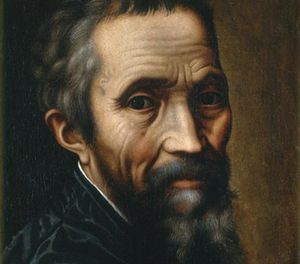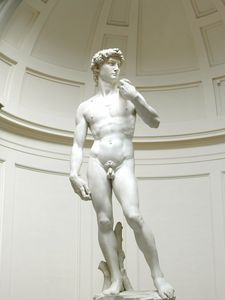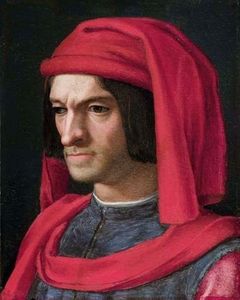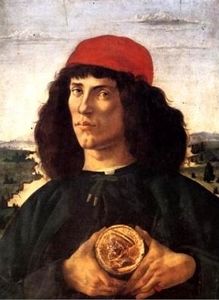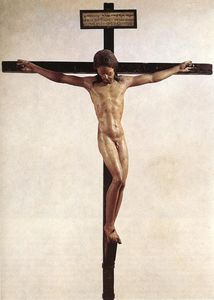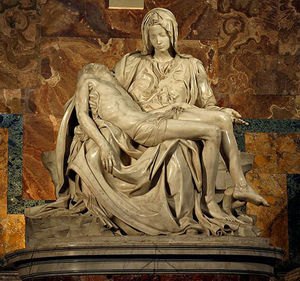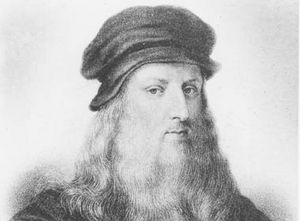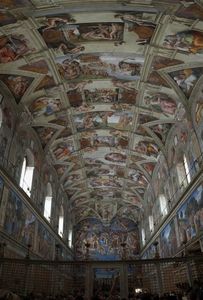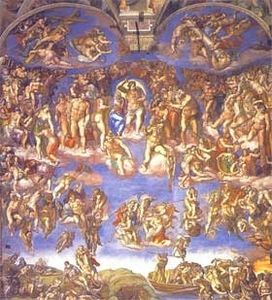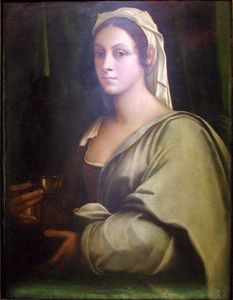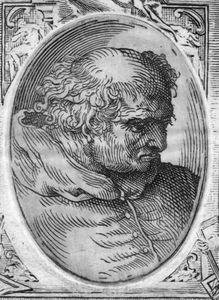Michelangelo Biography
- Full Name:
- Michelangelo di Lodovico Buonarroti Simoni
- Short Name:
- Michelangelo
- Alternative Names:
- Michelangelo
- Date of Birth:
- 06 Mar 1475
- Date of Death:
- 18 Feb 1564
- Focus:
- Paintings, Sculpture, Architecture, Drawings
- Mediums:
- Oil, Wood, Stone, Other
- Subjects:
- Figure, Fantasy
- Art Movement:
- Renaissance
- Hometown:
- Unknown City of Tuscany, Italy
- Living In:
- Florence, Italy
- Architecture:
- Saint Peter's Basilica
- Michelangelo Biography Page's Content
- Introduction
- Early Years
- Middle Years
- Advanced Years
Introduction
Michelangelo di Lodovico Buonarroti Simoni, more commonly called Michelangelo, was an Italian Renaissance painter hailing from the 16th century. A celebrated artist of his time Michelangelo was a sculptor, architect and painter of great talent who earned the admiration of the public and Pope alike.
Although he destroyed many of his sketches from the 16th century Michelangelo has one of the biggest artistic backlogs. There are numerous letters, paintings, sketches and notebooks left behind by the artist revealing a great deal about his working life. Furthermore, and rather unusually, during his lifetime there were two biographies written about him. Today Michelangelo legacy lives on.
Michelangelo Early Years
Michelangelo was born to his father Lodovico di Leonardo di Buonarroti di Simoni and his mother Francesca di Neri del Miniato di Siena in Caprese, Italy. His father's family had previously been bankers (although his own father worked occasionally for the government). Through his father Michelangelo believed himself to be descended from the Medieval Countess Mathilde of Canossa although this is not widely accepted by many genealogists.
His family moved from Caprese to Florence when Michelangelo was still a baby and he was given to a wet nurse. The husband and father of Michelangelo's wet nurse were both stone cutters, and the great artist often attributed his sculptural skills to drinking his wet nurse's milk.
Michelangelo's mother died when he was only six and he had a strict upbringing by his father. As a young man Michelangelo was sent to study with the scholar Francesco da Urbino. However to his father's distress Michelangelo did not enjoy his schooling and so at the age of thirteen was apprenticed to the artist Domenico Ghirlandaio.
When Michelangelo was fourteen Ghirlandalo recommended the young man to the ruler of Florence (Lorenzo de Medici) as one of his best pupils. Lorenzo had seen Michelangelo sculpt the head of a Faun and was highly impressed by his skills.
Between the years of 1490 and 1492 Michelangelo lived at the de Medici court and attended an academy in Florence. He studied under the sculptor Bertoldo di Giovanni (who was once Donatello's assistant) against his uncle and father's wishes, because they were unable to differentiate between being a lowly stonemason and a successful sculptor.
Michelangelo Middle Years
The ruler Lorenzo the Great died in 1492, which meant that Michelangelo had to leave the court and return to his family home. Between the years of 1492 and 1494 he produced the statue Hercules which was sent to rest in France. He also created his only wooden sculpture, Crucifix, which he gave to the church of Santo Spirito as a gift for allowing him to dissect corpses in the hospital.
In 1494 the new ruler of Florence, Piero de Medici, commissioned a snow statue from Michelangelo. The new ruler treated the artist with the same respect his father Lorenzo had and witnessing this, Michelangelo's father began to think of his son more fondly. However predicting that the de Medici family was going to be expelled from Florence the irritable Michelangelo decided to move to Bologna, Italy, a couple of days before the event occurred.
In Bologna Michelangelo met Gianfrancesco Aldovrandi and went to live with him. The De Medici family soon joined them and the group waited in Bologna until it was possible to return to Florence. Whilst staying in Bologna Michelangelo created some small marble figures in the shrine of St Dominic.
Back in Florence Michelangelo created the sculpture of Eros that made him famous in Rome. He made the Eros appear roughly two centuries older than it was at the request of Lorenzo de Medici. Lorenzo then gave the sculpture to a dealer in Rome who sold it to the cardinal S. Giorgio. Selling it as an antique for a highly inflated sum the dealer only gave the artist a small portion of his earnings. Hearing that he had been cheated the Cardinal sent a man to Florence to discover who had perpetrated the crime. Meeting Michelangelo the messenger realized that the artist had also been conned and took Michelangelo to Rome with him.
In Rome Michelangelo lodged with the Cardinal's man and all those who saw his Eros thought it beautiful. However the Cardinal was so incensed that he had been cheated by Michelangelo's work once that he never again commissioned a piece from the artist.
It was during this period that Michelangelo created his renowned Pieta, which now stands in St Peters Basilica in Rome. It is the only sculpture the temperamental artist ever signed after a rumor started saying it was the work of someone else.
After completing these pieces Michelangelo was required to return to Florence on family business. He created many works during this period including his statue David. It was in Florence that Michelangelo met the great Leonardo da Vinci and made his dislike of the older man obvious.
In 1504 Michelangelo once again moved to Rome to work on Pope Julius II's tomb. However the Pope was frequently distracted by other works and the tomb was not started. The temperamental Michelangelo blamed the architect Bramante for the Pope's distractions and claimed his rival was trying to sabotage his work.
Michelangelo Advanced Years
Michelangelo was commissioned by the Pope to begin the frescoes in the Sistine Chapel in 1508. He primarily considered himself a sculptor and at first attempted to turn the job down. Michelangelo believed that it was the other artists in the Vatican who had persuaded the Pope to hire him to paint the frescoes so that he would fail. However, with some convincing Michelangelo began the back breaking four year process that saw him painting over three hundred figures on the ceiling of the Sistine Chapel.
After Michelangelo had completed the ceiling he started work on the Pope's tomb once again. With a smaller budget he created some of his finest pieces during this period.
In the 1520s he returned to Florence to work on the Laurentian library but in 1528 the city was surrounded by German soldiers and Michelangelo's work was halted. After being forced to join the army and designing some effective defense strategies Michelangelo fled the city for Venice.
After a long and drawn out struggle Florence was eventually under the rule of a papal and Imperial alliance. Consequently the Medici governor of the city ordered the execution of Michelangelo because he had assisted the republic during the siege. Although the Pope pardoned his treason and Michelangelo returned to work on the Medici tombs, he decided to leave Florence for good in 1534. Despite the pardon Florence was ruled by the cruel Alessandro de Medici and Michelangelo was fearful for his life.
Michelangelo never returned to Florence due to the citizens' hostile attitude toward him regarding his behavior during the siege. In 1535 he began work on the fresco of The Last Judgment in the Sistine Chapel. The nudity of the figures in the Chapel caused uproar in the Vatican. Many of the Cardinals called the fresco 'blasphemous'. Consequently, a decade after the official unveiling of the Sistine Chapel another artist painted prudish robes onto the nude figures. After this Michelangelo created mainly architectural designs.
In 1538 Michelangelo met the woman who became one of his closest friends and confidants, Vittoria Colonna, an educated and beautiful woman living in Rome. She was a member of a revolutionary group that wanted to change the Catholic Church from within. Michelangelo penned a great deal of sonnets and poems to Vittoria until her death in 1547.
Michelangelo was a famously solitary man and this relationship is one of the only close friendships he had with a woman. He was wholly dedicated to his art and craft.
In 1546 Michelangelo took over the design of St Peters Basilica in Vatican City from the architect Sangallo who had passed away. Many architects, such as Raphael, had been involved in the planning of St Peter's Basilica but not a great deal of work had been completed. Even so there were a large number of changes that had been made to Bramante's original design.
Michelangelo abandoned Sangallo's plans and instead followed those of his old rival Bramante. Michelangelo was now in his seventies and he took the mighty responsibility extremely seriously. Despite criticism from other artists, Michelangelo did not accept any payment for his work.
In his nineties Michelangelo began work on his pieta for his own tomb, but, frustrated with the piece, he smashed it with a hammer.
Rumors plagued Michelangelo that he was growing senile. An old man whose closest friends had passed away he became increasingly sorrowful in his later years. He died on February 18, 1564 in Rome. Michelangelo was buried in the church Santi Apostoli but his nephew stole his body and took it back to Santa Croce in Florence, where the artist had wanted to be buried.

